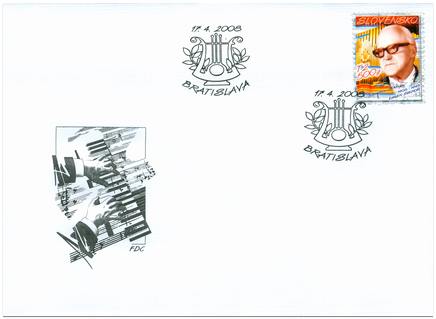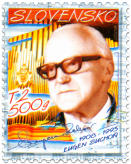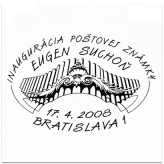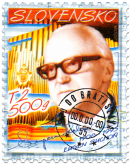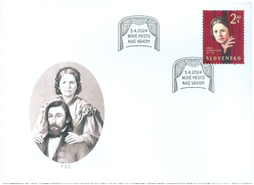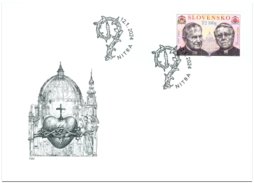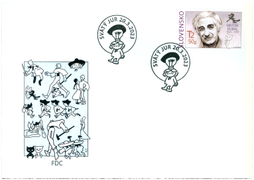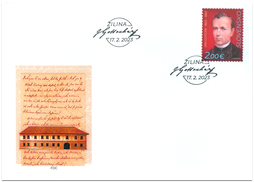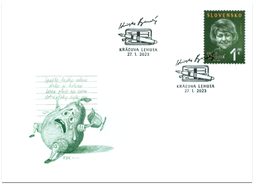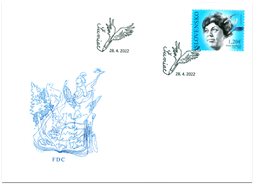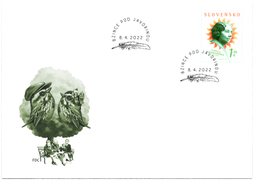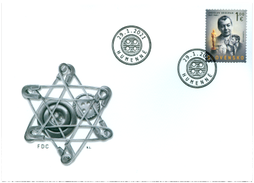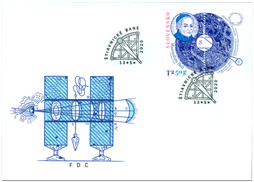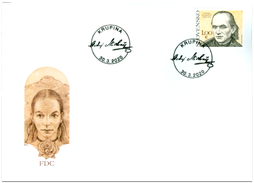FDC 418 Date of issue
17.04.2008 Sell price
1.20 €
T2 500 g responds to the rate of postage of the 2nd class up to 500 g - domestic servis. © Slovak Post, 2008 Professor Eugen Suchoň (25.9.1908 Pezinok – 5.8.1993 Bratislava) was a Slovak composer, pedagogue, and theorist, one of the most notable members of the founding generation of the Slovak ‘modernist’ movement in music. He studied the piano, composition, and conducting in Slovakia and the Czech Republic.His extensive palette of work includes the solo piano compositions Baladická suita (Balladic Suite, 1936), Malá suita s passacagliou (Little Suite with Passacaglia, 1931), Metamorfózy (Metamorphoses, 1952), Toccata (1973) and Elégia (The Elegy, 1978), but also other chamber music opuses such as Poème macabre pre husle a klavír (The Macabre Poem for Violin and Piano, 1963). Opuses such as Baladická suita (Balladic Suite, 1936), Metamorfózy (Metamorphoses, 1953), Rapsodická suita pre klavír a orchester (Rhapsodic Suite for Piano and Orchestra, 1965) and Symfonická fantázia na B-A-C-H pre organ, sláčiky a bicie nástroje (Symphonic Fantasia on B-A-C-H for Organ, Strings and Percussions, 1971), Burleska pre husle a orchester (Burlesque for Violin and Orchestra, 1933), and Fantázia pre husle a orchester (Fantasia for Violin and Orchestra, 1948) represent his most significant instrumental musical works. His approach to musical composition was influenced by his vivid and creative interest in Slovak folk songs. Eugen Suchoň devoted a great part of his musical efforts to vocal compositions, not only for solo singers accompanied by piano – as in the case of Bačovské piesne (Shepherd’s Songs, 1929, rev. 1985), Nox et solitudo (1932), Ad astra (1961), and Pohľad do neznáma (Glimpse into the Unknown, 1978) – but also for voice, choir and orchestra, as in Žalm zeme podkarpatskej (Psalm of the Carpathian Land, 1938). His compositional art reached its peak in his musical dramatic opuses, the most significant being Krútňava (The Whirlpool, 1949) and Svätopluk (King Svatopluk, 1960). Both operas are – though in a different manner – deeply rooted in homeland Slavic tradition and musical expression, both in terms of thematic elaboration and musical execution. Thanks to his unique compositional style coupled with the deep moral and ethical messages encoded in his work, Eugen Suchoň can be regarded as a modern composer when viewed from the broader perspective of contemporary European music. He is the founder of the modern Slovak opera and the holder of several awards. In 1958 he was granted the title ‘National Artist’. Suchoň’s pedagogical and theoretical works cannot be overlooked. He is the co-author of the bestselling Stručná náuka o hudbe (The Concise Theory of Music, written in cooperation with M. Filip, 1962) with several re-editions. His theoretical efforts have culminated in his Akordika – Od trojzvuku po dvanásťzvuk (Theory of Chords – From Three to Twelve Tune Chords, 1979). Eugen Suchoň definitely deserves a respected place in Slovak musical history, opera, Slovak musical culture, musical pedagogy, and humanism in general. Tomáš Surý
Show less© 2024 POFIS - Postal philatelic service. All rights reserved

